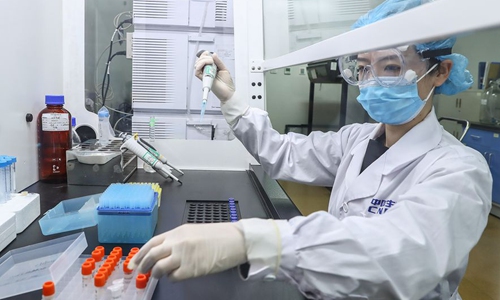Coronavirus mutations ‘inevitable’
By Liu Caiyu and Leng Shumei Source:Global Times Published: 2020/4/22 22:38:41
Regional differences can be useful in vaccine development: research

A staff member displays a sample of the COVID-19 inactivated vaccine at a vaccine production plant of China National Pharmaceutical Group (Sinopharm) in Beijing, capital of China, April 10, 2020. Photo:Xinhua
Mutations are already happening based on recent studies and a series of unexpected COVID-19 cases worldwide, like patients triggering an extended infection chain without showing symptoms, and infections with two different strains in Iceland, medical experts said on Wednesday.
But along with growing uncertainty in human's immunity brought about by the mutations comes opportunities to make use of these mutations to develop drugs and vaccines and lay out more targeted treatment therapies for COVID-19 patients.
The novel coronavirus is a kind of RNA virus and RNA virus mutates easily, according to a Beijing-based immunologist who required anonymity.
Some mutations may be good while others are bad depending on how they affect the virus' pathogenicity, infectivity and immunogenicity, which defines whether a patient would get affected with another strain of the novel coronavirus after recovery, the expert told the Global Times on Wednesday.
While there are some mutations that make the virus more pathogenic and infectious, some others would also happen in the opposite direction. The former offers an opportunity for researchers to develop attenuated vaccines while the latter requires targeted countermeasures, he noted.
Experts said whether the mutated virus reduces or enhances the infectivity requires scientific experimental verification and epidemiological investigations.
The coronavirus is an RNA virus, but its mutation rate is between one tenth and one fifth of that of other RNA viruses such as influenza and dengue, according to Lan Ke, the director of the State Key Lab of Virology from Wuhan University.
Lan stressed the importance of using its mutation window gap to stop the virus further from spreading among human beings.
A pre-print research paper was released on medRvix Sunday by a team led by renowned epidemiologist Li Lanjuan, saying that the team identified 33 mutations in samples collected from 11 patients and 19 of the mutations were novel.
The team said the study provides direct evidence for mutations in the novel coronavirus' genome, which have the functional potential to impact the viral pathogenicity.
Li's study reportedly provided the first evidence that mutation could affect the severity of the disease the virus caused. It also revealed some differences between various strains of the novel coronavirus based on regions.
For example, the most deadly strains were genetically similar to those spread in Europe and New York while the weaker strains were similar to those circulating in other parts of the US, such as Washington State, according to Li's study.
These results should be taken into account by not only drug and vaccine developers to avoid potential pitfalls, but also by hospitals who are treating COVID-19 as one disease regardless of the strain so as to increase treatment effect and decrease mortality, analysts said.
A COVID-19 case in Iceland made headlines worldwide in late March as the patient was confirmed infected by two strains of the coronavirus simultaneously.
The second strain is reportedly a mutation of the original novel coronavirus and could be more infectious because people infected by the dual-strain patient were only found to have the second strain.
Such mutations deserve concern as they may bring uncertainty to human's anti-epidemic battle and targeted management measures should follow to prevent the potential risk of virus spread, the anonymous expert said. However, he noted that there is no need to overreact as such cases are rare.
The city of Harbin in Northeast China and Beijing continuously reported cases who tested negative during their quarantine but started to show symptoms and infected others once they went back home.
Beijing health authority Sunday suggested people finished 14-day quarantine to accept another 7-day home-based observation to prevent such incident, which experts said is a prudent and reasonable move in face of threats from these rare cases.
It is not clear whether these cases are caused by virus mutations, but, theoretically, it is normal that asymptomatic cases and long-incubation cases would increase in summer, between May-September, as humans' immunity system is stronger and more stable than in winter, according to the anonymous expert.
The activity of the virus would also decrease in this period due to long hours of light and stronger ultraviolet rays, he noted.
Posted in: SOCIETY